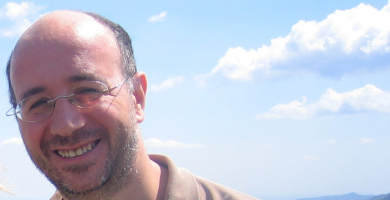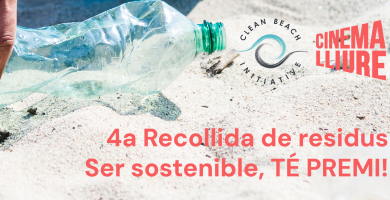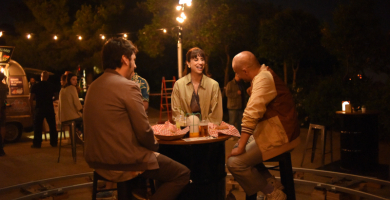
Xavier Cazeneuve: "A big contemporary city is also big because it has films which show it. When it contains cinematographic memory".
We interview Xavier Cazeneuve, historian and founding partner of Barchinona.cat. We talk with him about the relations between Barcelona and films on a historical and urban planning level.

What is Barchinona.cat and how did it arise?
It is a project which arose from a personal concern as a historian with a 30-year career. As a resistant historian, one they call freelance, self-employed, or whatever you want, without being attached to any institution, and over time you have gradually made a living from matters related to the history of Barcelona. As a result of the subjects on which I have managed to work and of my personal research, I collected a whole series of materials which were always in boxes or in computer databases. The first idea was to create a website of resources on subjects of the history of Barcelona. Over the years, you end up thinking that there may be a business project behind this. Barchinona is a three-way project: research, company and resources.
As research, it links everything on which, as historians with our individual concerns, we undertake research, in fields which are not our own or the result of our personal obsessions; these include the relations of Barcelona with films. And we try to channel them toward the other two aspects: resources and company. The first is our website with resources on the historiography of Barcelona. We also, for example, send a weekly newsletter with an agenda of events related to the history of Barcelona which you can attend throughout the week. Then there is the company part, which we try to live on, which is the generation, proposal and acceptance of all those jobs or assignments, in a sphere, that of history, in which we can do everything, from reviewing a book, coordinating an exhibition or a project on new technologies and documentation, on which we have been working a lot lately.
And what is the relationship with film? What studies do you carry out related to audiovisual and the city?
This is a more purely personal aspect of mine. A concern which arose initially on seeing that through old films from the 40s or 50s it was possible to carry out “urban planning archaeology”. Outside spaces of the city, which have been considerably transformed or have disappeared, appear in these films. I saw that, on taking note of all these exteriors, it was a source of knowledge complementing other (textual, photographic, planimetric...) sources which I already have on Barcelona urban planning. What happens is that you then go a little further and you begin to see that the city has been treated in many ways through film, and then you find a new field of study. Within overall knowledge of the city, partial knowledge is like film, like art that we have in the 20th-21st century, it has reflected the city. Just like literature, painting or even urban planning has done, film also talks to us in certain way about Barcelona and it is important to analyze it because it is a reflection of how the city is seen by an important form of expression (aesthetic, ideological, etc.) of the 20th century and the 21st century so far.
Do you think that Barcelona is well represented on a historical level in film?
Barcelona is a big city and in relation to this sphere, from the cinematographic point of view, it is also big. I do not know how many films have been shot in Lleida, Girona, Tarragona, L’Hospitalet, Terrassa or Sabadell, with all due respect for these cities. And not just on a Catalan level, but even a Spanish or European level. A big contemporary city is also big because it has films which show it. When it contains cinematographic memory. Having said this, and from now on, we should be very clear that films, even historical films, are an artistic expression of the moment when the film was made. Therefore, wanting to look for historical reality in film already confronts us with a problem. The only historical “reality” is that, although a film talks to you about Barcelona in the 1920s, if it is shot in 2019 it is talking to you about Barcelona in 2019. In any case, it is talking to you about how Barcelona in the 1920s is seen in 2019. We cannot understand it as a source of knowledge about the 20s as if it were a primary documentary source. In any case, it is secondary, and always through a criterion of interpretation and of textual criticism which must be very rigorous. Because, otherwise, what occurs is that we think that because we have seen films about Romans we already know what the Roman Empire was likely, and that is not the case.
Another issue is the quantity of films that have dealt with historical aspects of the city. Here I would tell you that the number is not very high. Could we really trace the history of Barcelona through film? It’s complicated. But that doesn’t just happen here. On the other hand, this does not mean that, through films, even those not shot in Barcelona, you cannot interpret very well what happened in Barcelona at a certain time. I’m thinking about Rocco and His Brothers, by Visconti. It is a film which permits me to understand very well what happened in Barcelona in the 50s with immigration from other parts of Spain. With the families who came as immigrants, and their “internal confrontation” between the rural world from which they came and the urban world where they found themselves. How the city is organized for new arrivals, how they try to earn a living and how, for example, one of the brothers in the film ends up working in Alfa Romeo like here so many men ended up working in Seat. You see this film, which talks to you about Milan in the 50s, and you can understand perfectly well what Barcelona was like in this aspect, differences aside, in those years.
There are also many films which are shot in Barcelona as if it were another city.
This is a fantastic! Personally, I find it very entertaining when Barcelona is disguised as a character actor. It’s incredible, because Barcelona can be Berlin and Havana in the same film. Or when Barcelona can be Fu Manchu’s Castle or Transylvania in a Dracula film. Or a tough United States city, like in The Machinist. It gives the city a cosmopolitan touch, in the sense that film allows it to be disguised as other cities. The city can even be disguised as other times. Sometimes, the same exterior has been used in a film set in the 19th century, and another set in the first third of the 20th century and another in the present. We have above all the half-invented area of the Gothic quarter, in which you have settings which have been used for The Truth about the Savolta case and for Cathedral of the sea.
This leads to a collateral phenomenon, a “problem” which many of us who know the city and who see films shot here have, and that is that a certain film device does not work. You see that someone enters a street, goes round the corner, and suddenly you realize that they are now in a different neighbourhood, very far from the point where they were just before going round the corner! This type of cinematographic device, which is normal in film, as a result of the planning and the editing, provokes in the settings that you know a break in the understanding, a visual barrier, we could say, which is very big, disturbing, and at the same time entertaining.
Is there any film that you have seen in which you couldn’t believe our eyes, saying: “That’s impossible”?
I’m sure, but I can’t think of any at the moment… But I don’t give much importance to that. I am also well aware that this is cinema, that it is not a documentary (despite the fact that we should talk about whether documentaries really explain reality and objectivity and all that). If a museum did that or the council selling Barcelona… then maybe it would be questionable. But we’re talking about films, fictional products, at the same time as commercial products, based on the artifice of language and cinematographic techniques, with their own rules. Another very funny thing, related to what we were saying before, is when you see in Jess Franco’s Count Dracula from 1970 the main square of Pueblo Espanyol and in the film it’s the main square of Dracula’s town in Transylvania, or that the Tinell and the Chapel of Santa Ágata are Dracula’s castle. Or with Fu Manchu by the same director, in which Park Güell is Fu Manchu’s Castle. It’s very funny! And I admire it thanks to the joy and disinhibition that it shows! In Count Dracula, near the beginning of the film, there are two policemen who are supposedly fishing for trout in Scotland… And you see that they are doing it in a boat on the lake in Ciutadella Park! And it works!
In the cinematography of Jess Franco, to talk just about one director, we find many other similar cases. In Marquis de Sade: Justine (1969), the Casa de l’Ardiaca, the current headquarters of the Historical Archives of Barcelona, is a convent of nuns. How did they shoot all this? It is clear that the question of licences was different then. It’s wonderful.
And, if you don’t have the resources, you have to be inventive.
It’s fantastic. This demonstrates that reality can be seen in so many different ways! It’s also like a dose of humble pie. It’s the fun aspect of film which I like a lot when it is applied to the city in this case.
The analysis of Barcelona, the city itself, in film is something else. For example, the analysis of Barcelona in the 40s and 50s, as it has been reflected, the whole subject of the Barcelona School, for example, with those films about robbers and night watchmen, and what city it was showing and what city it wanted to set up against the official language, for example of the NO-DO. Or, in line with this, how at the same time there were NO-DO reports on how here it was a land of milk and honey, with the trade shows and blah, blah, blah and at the same time there were underground films which talked about immigration. And which talked about people who lived in slums, who could not find work, and they were cinematographic expressions from the same years. The contrasting viewpoints on the city through film in its different versions offers you a multifaceted view and interpretation of contemporary Barcelona which you could maybe also obtain through other documentation but which, in this case, has its own different nuance. I find this very interesting.
One of the lines of your research is the relations that films establish with Barcelona starting from newly developed urban spaces?
We could establish some outlines of theories which are confirmed as I gradually increase the database of films. Maybe the one that is clearest for me is that films advertise the urban transformations of Barcelona. In the same way that, starting from 1992/1993, when in Barcelona you wanted to shoot a film and you had to give an image of modernity you shot in the Olympic Village. Even series on TV3 were shot there. In the same way you find that, at least since the 40s, when films wanted to show a character, atmosphere or situation linked to modernity or prosperity, they very often show you recently developed areas. There is a film about robbers and night watchmen called El cerco by Miguel Iglesias (1955). It begins with a robbery which does not go well and one of the robbers is badly injured. At a certain time they go to the flat of the head of the gang’s girlfriend. This girl represented everything modern. And I see that the thieves arrive in an area and park, a scene shot outside. It was a place which I did not recognize at first glance. I stopped the image of the DVD and concentrated: where is this? It was the current Avenida Josep Tarradellas, previously Infanta Carlota. I looked at the release date of the film and it just so happened that the avenue had been developed just one year earlier. In another film, Los cuervos (Julio Coll, 1962), about a businessman who has a very modern state-of-the-art company, when it shows the factory from outside, you see that it is shot showing the new Lámparas Z factory which opened just three years earlier.
We could make a selection of films with certain scenes and we could trace the urban planning evolution of the city in relation to newly developed or built areas. The same happened with the Olympic Harbour in the 80s. In Barcelona, when we have a new outfit, films come and try it on.
One of your projects is also to study the image that NO-DO gave of Barcelona. This is an archive with many images of the city. What image did it give?
When I discovered that the Filmoteca Española had uploaded all the NO-DOs with free public access, I was curious to see the first one, from 1943. It contains just two seconds on Barcelona, when it talks about the Santa Llúcia fair. However, in the images you still see the block of houses on Calle de la Corribia, which was a block which separated the Plaza Nueva from Pla de la Catedral and which was demolished a few years later. And, moreover, Santa Llúcia fair is not, for example, like the one that exists now with four rows of stalls; no, it really occupied the whole of Pla de la Catedral, the pavements of this block that I mentioned and the whole of Plaza Nueva. This is spectacular for us today. And full of people. When I saw that they were moving images of that area which was so different from what it is like now, I thought that with the No-Do there could be a line of study or urban development information to follow.
Then, when it came to beginning to look and compile, you see that there is a very specific view of the NO-DO on the city of Barcelona. And the subject becomes much bigger. With this research project, which we are carrying out for our own account and which we have not yet finished, we have already completed an initial phase which is the compilation of all the programme handouts, with all the related news items from the NO-DO from 1943 to 1982. Compiling all the news items by location. Not just for Barcelona, therefore, but also for Catalonia, Spain and the world. To know the importance that the city of Barcelona could have in the NO-DO you have to compare it with something. And obviously “that thing” is Madrid. They were the two important cities. I think that the third was Valencia or Seville and they were quite a way behind.
The NO-DO is frivolous, an opium poppy. It does have an ideological component, but it does not have what programmes like Polònia give it. It is not the devil’s voice speaking. It is, however, Mephistopheles; it is very sibylline. It is not the Emperor of the dark side. In the 40s, in the first NO-DOs until the end of the Second World War, still, but then it was diluted much more. The No-Do was used for people to see in what a placid country and in what a conflict-free society they lived. It does not talk about important things; it is full of insignificant news items and some which are absurd, and this is also worth analyzing. Even so, on the No-Do you can see how the Franco regime faces up to the evidence that Barcelona was Spain’s most dynamic and modern city… It shows it as the most advanced city.
In relation to the NO-DO being like a sort of opium poppy, one of the things that I would like to criticize is its use when people want to show images of Spain during the dictatorship. Too often the news and reports use images from the NO-DO. We must be careful. This is a sort of concession to a dangerous melancholy, because in the NO-DO the images are always conflict-free, placid. And the worst thing that can happen when you see the NO-DO is that you end up smiling. Then it has won. And the dictatorship, and its ideological followers, win. It is a question of “tell me how beautiful the world was before”.
As I was saying, so far we have finished compiling the programme handouts and we are now comparing them and completing them with the images. This is the second part that we will gradually do, with time and a beer and, as I said, at the moment this is research that we are doing for our own account.
Your work also includes supporting film scripts. What does your work consist of in relation to this?
Leaving aside the analysis of what is seen in films, we have a whole professional side which consists of what we know that there is in the city. Beyond what has already been shot or not shot. When they are looking for exteriors, at a certain time, I can give a very easy example because it is distant and it does not affect us. When the film version of Perfume: The story of a Murderer was made, there is a whole sequence which takes place with the main character discovering Paris and breathing in its smells. Of course, I see it and I say: impossible! He’s walking along Calle Ferran and the architecture which is around him, although there is a lot of scenery added, consists of 19th-century facades and behind you can see part of Plaza San Jaime. As I said before, this is not at all important for a fiction film, and those of us who realize are not important. However, sometimes you see things or things happen, importance is given to settings, above all when biographical films of historic characters are shot, when they represent spaces which are where the subject of the biography lived, and you say: don’t put that, because this area didn’t exist in the time of the man or the woman that you are talking about. In this respect, it is more a question of advice about exteriors rather than historical advice strictly speaking, since for the latter there are other companies which can do it much better than us.









